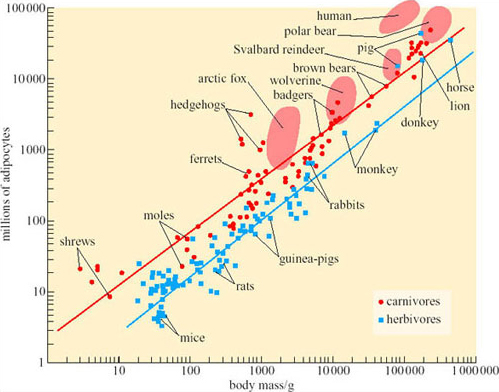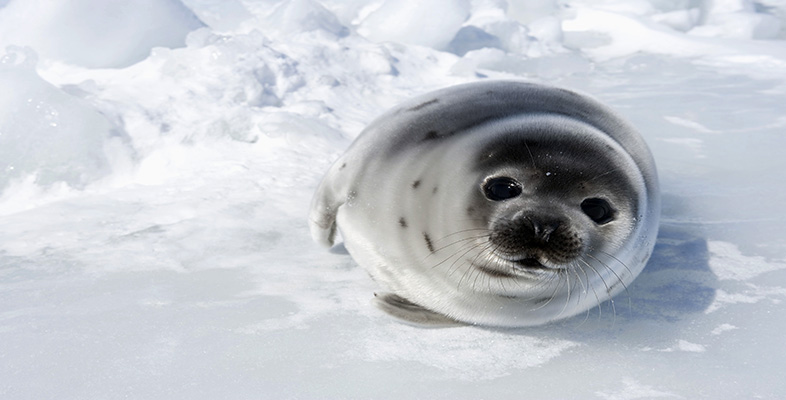3.5 The structure of adipose tissue
Since food is only available seasonally or intermittently at high latitudes, many arctic birds and mammals, including polar bears, Svalbard reindeer, arctic foxes, seals and walruses, naturally accumulate large stores of fat. The quantity of energy stored and the metabolic control of its use are finely adjusted to the habits and habitat of the species. This section is concerned with the cellular structure and anatomical organization of adipose tissue in such naturally obese species. Most laboratory mammals do not naturally become obese, and must be induced to do so by drastic measures such as changes in diet, drugs or surgery. Although it is impossible to carry out as detailed measurements or carefully controlled experiments on wild animals as it is in the laboratory, arctic species provide a rare opportunity to study fattening and obesity as natural phenomena, rather than as pathological or artificial conditions. Observations on these naturally obese animals can help resolve discrepancies between mechanisms that can be demonstrated experimentally in rats and those that seem to occur in people.
One important aspect of obesity is the contribution of adipocyte enlargement and the formation of additional adipocytes to animals’ increased capacities for storing lipid. In adult rats and mice, fattening is achieved almost entirely by enlargement of adipocytes: the number of cells does not change. The matter is not easy to investigate in humans because there is no really accurate, non-destructive way of measuring total adipocyte complement, but indirect estimates suggest that the accumulation of more adipocytes makes a significant, in some people the dominant, contribution to obesity. In order to establish whether adipocyte proliferation is also essential to expansion of the lipid storage capacity in naturally obese arctic animals, we have to find a way of calculating how many adipocytes would be expected in an animal of any particular body mass. Figure 16 shows some measurements of the numbers of adipocytes in some temperate-zone and tropical mammals (Pond and Mattacks, 1985). The equations for the regression lines drawn on Figure 16 can be used to calculate the number of adipocytes expected in an animal from its body mass. The predicted adipocyte complement can then be compared with the measured adipocyte complement.
Such comparison shows that naturally obese arctic mammals such as polar bears, arctic foxes, wolverines (large mustelid carnivores, related to otters, stoats, weasels, mink, ferrets and badgers) and reindeer have more adipocytes than expected, usually between twice and four times as many, although a few specimens have almost exactly the predicted number of adipocytes. Such proliferation of adipocytes is modest compared to that of humans: some obese people have more than ten times as many adipocytes as expected from comparison with the data in Figure 16.

However, the adipocyte complement of the wild mammals was found to be quite variable in otherwise similar specimens collected from the same area at the same time. Many factors such as hunting ability and appetite determine individual differences in fatness, but among the carnivores there was no evidence that individuals with more adipocytes were normally any fatter than those with fewer adipocytes: the adipose tissue of the former simply consisted of numerous, relatively smaller adipocytes. Individual variation in adipocyte complement is also observed in humans, with some people having relatively few, large adipocytes and others more numerous smaller ones, but it is not as conspicuous in laboratory rats, all of which seem to have about the same adipocyte complement in relation to their body mass unless artificially manipulated to make them unnaturally obese.
SAQ 20
Do these observations suggest that people who have large adipocyte complements are, or will inevitably become, obese?
Answer
No. In the wild carnivores, fatness does not correlate with adipocyte complement. The same may be true of other mammals including people.
We know very little about the origin of such individual differences in adipocyte complement: adipocyte proliferation takes place mainly during the suckling period, and the exact course of growth at this age may differ from one individual bear, arctic fox, wolverine and reindeer to another, depending upon the number of littermates and the amount of food available to its mother.
SAQ 21
Would it be possible to determine the fatness of a particular bear or reindeer by measuring the volume of a sample of its adipocytes?
Answer
No. Adipocyte volume would not be an accurate measure of fatness because the relationship between the total mass of adipose tissue and the volume of its adipocytes would be different in specimens that have large or small adipocyte complements.
Unfortunately, assessment of fatness from biopsy samples of adipose tissue is much more satisfactory in rats (because their adipocyte complement is more constant) than it is in either naturally obese arctic mammals or in humans.
